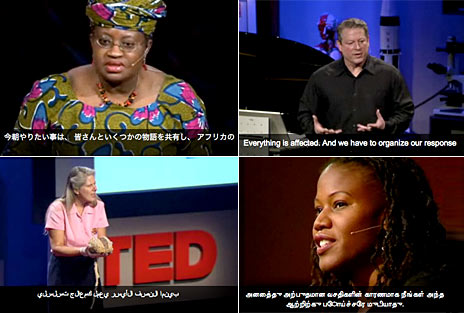We here at TED are thrilled to announce this news!
NEW YORK, May 13, 2009 — The acclaimed 18-minute talks available free on the TED website will now be accessible beyond the English-speaking world, through the TED Open Translation Project (www.ted.com/translation), which launches today, generously sponsored by Nokia.
A year in the making, the project offers video subtitles, time-coded transcripts and the ability for volunteers worldwide to translate any talk into any language. The project launches with 300 translations in 40 languages; more than 200 volunteer translators have already contributed.
Download the Open Translation Project press release as a PDF >>
“TED’s mission is to spread good thinking globally, and so it’s high time we began reaching out to the 4.5 billion people on the planet who don’t speak English,” says TED Curator Chris Anderson. “We’re excited to be using a bottom-up, open-source approach that will in time allow all our talks to be translated into all the world’s languages. A web-empowered revolution in global education is under way. We’re not far from the day when anyone on Earth can directly access the world’s great teachers speaking to them in their own language. How cool is that?”
Each of the 400+ talks on TED.com will now offer:
+ Subtitles, in English and many additional languages (several videos carry up to 25 languages at launch)
+ A time-coded, interactive transcript, in multiple languages, which lets you click on any phrase and jump straight to that point in the video. This makes the entire content of the video indexable on search engines
+ Translated headlines and video descriptions, which appear when a new language is selected
+ Language-specific URLs which play the chosen subtitles by default
The TED Open Translation Project is one of the most comprehensive attempts by a major media platform to subtitle and index online video content. It’s also a groundbreaking effort in the public, professional use of volunteer translation.
“Volunteer translation will be increasingly important for anyone trying to reach a global audience,” says June Cohen, Executive Producer of TED Media. “It’s the only feasible way to reach all the world’s languages. Crowd-sourced translation creates communities of volunteers who are passionate about producing great work, accountable for the accuracy of their translations, and invested in evolving the system itself. It turns users into true participants, helping to spread ideas.”
Crowd-sourced translations in all the world’s languages
To launch the Open Translation Project, a handful of talks were professionally translated into 20 languages. But all translations going forward will be provided by volunteers. In fact, volunteer translators have already contributed more than 200 published translations to the project (with 450 more in development). These volunteers range from well-organized groups working together in their own language, to lone translators working individually and matched by TED with others.
To support this program, TED and technology partner dotSUB have developed a set of tools that allow participants around the world to translate their favorite talks into their own language. This approach is scalable, and — importantly — allows speakers of less-dominant languages an equal opportunity to spread ideas within their communities.
This open-source approach mimics the successful strategies of products like Wikipedia, Linux and Mozilla, which have proven the power -– and ultimate reliability –- of open solutions. Crowd-sourced translation has already been proven effective on a handful of sites worldwide, including Wikipedia and the Global Voices blog at Harvard’s Berkman Center for Internet & Society.
To ensure quality translations, TED established a set of guidelines and systems to help translators deliver the best work possible. To begin with, a professionally generated (and speaker-approved) English transcript is provided for each talk, so that all translations are based on the same source document. TED then requires every translation to be reviewed by a second fluent speaker before it’s published; both translator and reviewer are credited by name on the site. TED controls the final “publish” button (nothing is “automatically” published), and there are feedback mechanisms for ongoing community input and improvement after publication.
At launch, TED’s Open Translation Project will include more than 300 translations, in more than 40 languages, including Arabic, Bengali, Bulgarian, Chinese, Danish, Dutch, Finnish, French, German, Greek, Hebrew, Hindi, Hungarian, Italian, Japanese, Kannada, Kirghiz, Korean, Norwegian, Persian, Polish, Portuguese, Romanian, Russian, Spanish, Swahili, Swedish, Tamil, Telugu, Thai, Turkish, Urdu and Vietnamese. Our translators hail from cities from Beijing to Buenos Aires; Tehran to Tel Aviv; Espoo, Finland, to Barranquilla, Colombia.
Accurate, searchable, interactive transcripts for every TEDTalk
Each of the 400+ TED talks now has a time-coded, interactive transcript, in English and all available languages. Using this interactive transcript, a user can select any phrase and have the video play from the point where that phrase is spoken. The transcripts will be fully indexable by search engines — in all languages — exposing previously inaccessible content within the talks themselves. For example, someone searching on Google for “green roof” will ultimately find the moment in architect William McDonough’s talk when he discusses Ford’s River Rouge plant, and also the moment in Majora Carter’s talk when she speaks of her green roof project in the South Bronx.
Questions about the project? Write to subtitles@ted.com or read the FAQ.

Comments (39)
Pingback: Talk geven? Lees hier hoe je dat TED-waardig doet - De Presenteerschool
Pingback: De talk: een ideaal middel om ideeën te verspreiden - De Presenteerschool
Pingback: The Macro Conversation: How Absolut’s Afdhel Aziz is making ‘good’ look ‘cool’ – MAC Presents
Pingback: iLLi noDi saar! Code-u!
Pingback: TED + Subtitles « My English Images's Blog